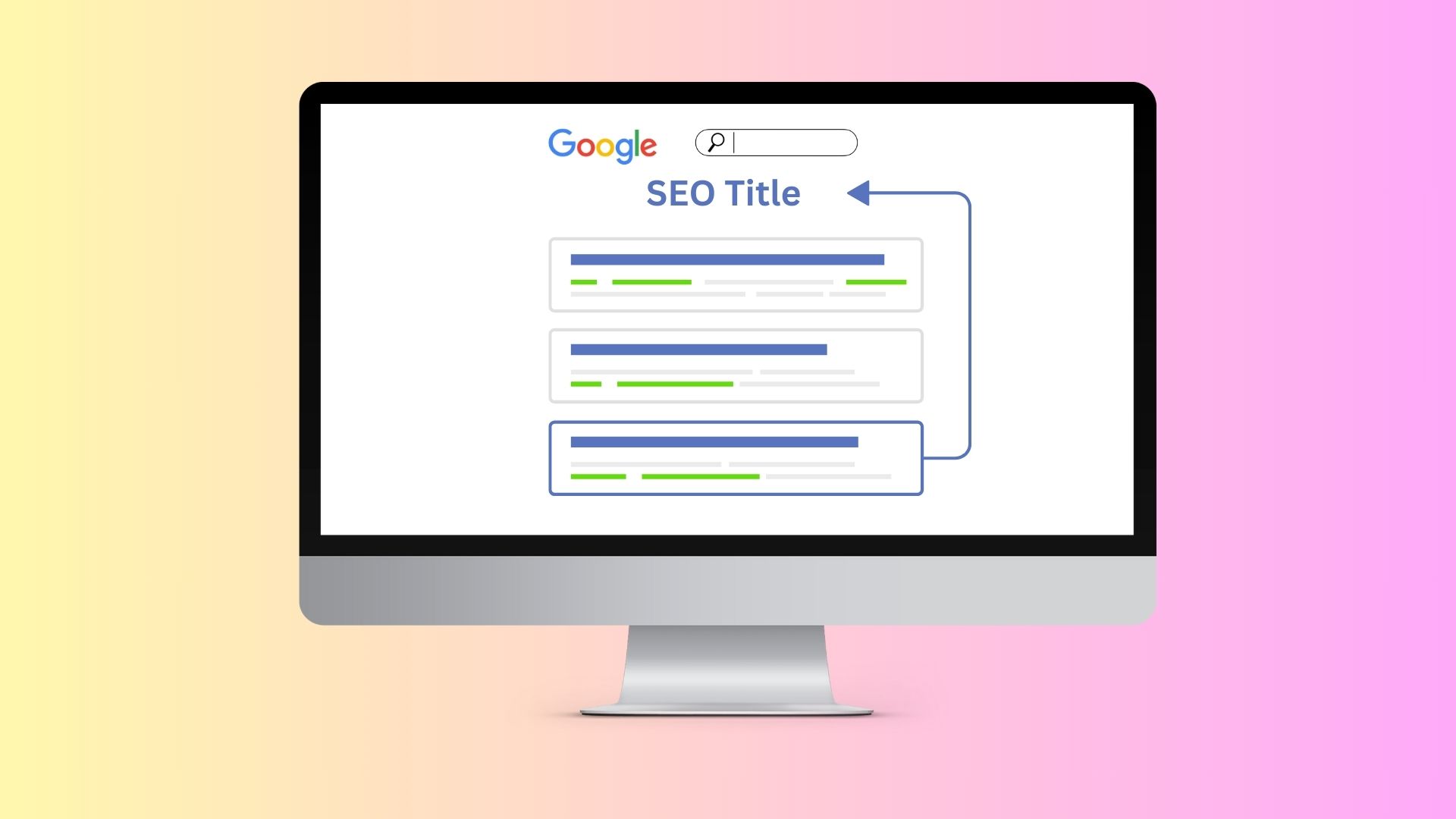Table of Contents
SEO Site Titles in WordPress: A Beginner’s Guide
If you’re new to WordPress and SEO, one of the first things you’ll need to understand is how to create effective site titles also kown as SEO titles in WordPress. These little pieces of text might seem simple, but they play a huge role in helping your website show up in relevant search results and attract visitors to your website.
What is an SEO Title in WordPress?
An SEO title (also called a meta title or page title) is the text that appears at the top of your web browser and in search engine results. It’s like a headline that tells both search engines and potential visitors what your page is about.
When someone searches on Google, your SEO title is the blue, clickable text they see first on the search engine results page (SERPs).
For example, if you run an HVAC business your site title might appear as “Best HVAC company in Orange County.”
Why SEO Titles Matter
Your SEO titles are important for three main reasons:
- They help search engines understand your content: Search engines like Google use these titles to figure out what your pages are about and rank it for relevant search terms.
- They affect click-through rates: A good title can convince more people to click on your link in search results. The better your click-through rate, the better your web page and website will perform on search engines.
- They help with organizing bookmarks: When people bookmark your pages, the SEO title is what they’ll see in their bookmarks list.
Best Practices for Writing SEO Titles
Here are the most important rules to follow when writing your titles:
1. Keep It Under 60 Characters
Google typically shows only the first 50-60 characters of a title in search results. Anything longer gets cut off with (…). Think of it like a tweet – you need to get your message across in limited space.
2. Put Important Keywords First
Start your title with the words people are most likely to search for. For example:
-
- Bad: “Welcome to Our Guide About Growing Tomatoes”
-
- Good: “Growing Tomatoes: A Beginner’s Guide to Garden Success”
3. Include Your Brand Name (Usually)
Add your site or brand name at the end of the title, separated by a pipe symbol (|) or a dash (-). Like this: “HVAC Services in Orange County | HVAC Experts Inc.”
4. Be Specific and Accurate
Your title should match what’s actually on the page. Don’t promise something in the title that isn’t delivered in the content. This helps build trust with both visitors and search engines.
How to Set Up SEO Titles in WordPress
There are two main ways to add/edit SEO titles in WordPress:
1. Using an SEO Plugin to Add SEO Titles (Recommended)
The easiest way is to use an SEO plugin like Yoast SEO, All in One SEO Pack, or SEO Press. Here’s how:
- Install and activate your chosen SEO plugin
- Go to your post or page editor
- Scroll down to find the SEO section (usually below the main content area)
- Enter your custom title in the “SEO Title” or “Meta Title” field
Using a plugin gives you more control and helps you preview how your title will look in search results.
2. Using WordPress Theme Settings to Add SEO Titles
Some WordPress themes let you customize titles through the theme settings. However, this method usually gives you less control than using a dedicated SEO plugin.
Common Mistakes to Avoid
1. Avoid Keyword Stuffing
Don’t do this: “Dog Training Tips Dog Trainer Dog Classes Dog Behavior | Dog School”
Instead, write naturally: “Professional Dog Training Tips for Beginners | Canine Academy”
2. Don’t Use the Same Title Format Across Your Entire Website
Don’t use exactly the same format for every page. Mix it up based on the content type:
-
- Blog posts: “How to [Topic]: [Benefit] | [Brand]”
-
- Product pages: “[Product Name] – [Key Feature] | [Brand]”
-
- Service pages: “[Service] in [Location] | [Brand]”
3. Don’t Forget About Mobile Users
Remember that titles appear differently on mobile devices. They often get cut off sooner than on desktop, so put your most important words first.
How to Check If Your Titles Are Working
Here’s how to know if your SEO titles are effective:
- Look at Your Search Traffic Use Google Search Console to see which pages get the most clicks from search results.
- Check Click-Through Rates If lots of people see your page in search, but few click, you might need a better title. The higher the click-through rate, the better.
- Test Different Formats Try different title structures for similar content and see which performs better.
SEO Title Formulas and Examples
Creating strong SEO titles can feel like a challenge, but using proven formulas can make it easier to craft titles that work. Here are some simple, effective title structures to try, along with examples for an HVAC business to help you visualize them in action.
1. How-to [Benefit] in [Year] | [Brand]
Use this formula when you’re offering helpful advice or a guide on a specific topic. This format works well for blogs and informational content because it appeals to users searching for solutions.
-
- Example: “How to Save on Heating Bills in Winter 2024 | HVAC Experts”
-
- Example: “How to Keep Your Home Cool in Summer | HVAC Experts”
2. [Service] in [Location] – [Benefit]
This structure works well for service pages, especially for businesses targeting specific locations. Including the service, location, and a benefit lets users know what you offer and why they should choose you.
-
- Example: “AC Repair in Orange County – Fast and Reliable Service”
-
- Example: “Heating Installation in Anaheim – Affordable, Expert Help”
3. [Number] Tips for [Problem/Goal] | [Brand]
Lists with numbers grab attention and suggest helpful, easy-to-read content. This format is ideal for blog posts, listicles, or tips articles.
-
- Example: “10 Tips for Reducing Your Heating Costs | HVAC Experts”
-
- Example: “5 Easy Ways to Improve Air Quality at Home | HVAC Experts”
4. [Service] Near Me – [Key Benefit]
“Near Me” searches are popular, especially on mobile devices. This title formula helps you reach local customers looking for quick solutions nearby.
-
- Example: “HVAC Repair Near Me – 24/7 Emergency Service”
-
- Example: “AC Maintenance Near Me – Reliable and Affordable”
5. Best [Service] in [Location] | [Brand]
If you want to emphasize quality and expertise, this title format can help build trust. It’s perfect for service pages or homepages where you want to showcase your brand’s strengths.
-
- Example: “Best HVAC Services in Los Angeles | HVAC Experts”
-
- Example: “Top-Rated Air Conditioning Repair in Orange County | HVAC Experts”
6. [Year] Guide to [Topic/Service] | [Brand]
Including the current year signals fresh, relevant content. This title style is great for guides and resources, especially for seasonal or annual updates.
-
- Example: “2024 Guide to Energy-Efficient Heating | HVAC Experts”
-
- Example: “2024 AC Maintenance Checklist | HVAC Experts”
7. [Pain Point] Solution – [Service/Brand]
Identify a common problem your customers face, then offer your service as the solution. This format works well for blog posts, guides, and problem-solving content.
-
- Example: “Trouble with Your Furnace? Reliable Repairs by HVAC Experts”
-
- Example: “Allergies Acting Up? Improve Air Quality with HVAC Experts”
Rankwise PRO Tips for Better SEO Titles
-
- Use numbers when relevant: “7 Easy Ways to…” often performs better than “Easy Ways to…”
-
- Include the current year for time-sensitive content: “Best Gaming Laptops 2024”
-
- Ask questions if they match search intent: “How to Start a Blog?”
-
- Use power words like “essential,” “ultimate,” “complete,” but don’t overdo it.
-
- Make sure each page on your site has a unique title
Final Thoughts
Good SEO titles are like welcome signs for your website. They need to be clear, honest, and inviting. Start with these basics, and as you get more comfortable, you can experiment with different formats to see what works best for your audience.
Remember, the best SEO title is one that accurately describes your content and makes people want to click. Don’t overthink it – focus on being clear and helpful, and you’re already on the right track.
Frequently Asked Questions (FAQs)
An SEO title (or meta title) is the title that appears in search engine results and at the top of your browser tab. Its main job is to help search engines understand your page and encourage people to click. A headline, on the other hand, is what readers see directly on your webpage and is meant to grab their attention once they’re already on the page. While the SEO title and headline can be similar, the SEO title usually focuses on keywords for search visibility, while the headline speaks directly to readers.
You don’t need to update SEO titles frequently, but it’s a good idea to review them every few months or when making content updates. Check for outdated information, like including a year if relevant (e.g., “Best Tips for SEO in 2024”), and see if there are opportunities to make your titles more engaging or keyword-focused. Regularly reviewing your titles helps keep your content fresh and aligned with search trends.
Yes, they can! Some social media platforms pull your SEO title as part of the preview when someone shares your link. An eye-catching, informative SEO title can encourage more clicks and engagement on social media. For more control, you can set a specific title for social shares using tools like Yoast SEO or All in One SEO Pack, allowing you to customize how your content appears across different platforms.



